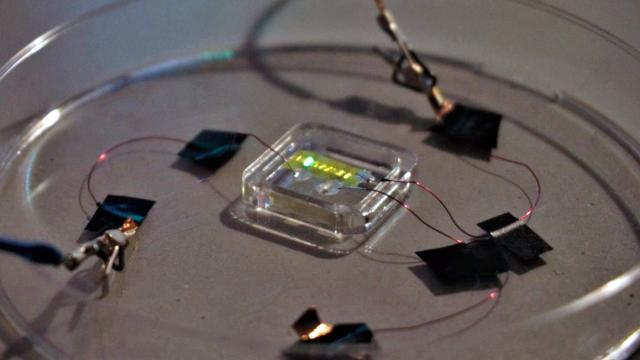Tattoos are usually considered a form of personal expression, but a team of researchers in Europe have created what they’re calling the world’s first light-emitting tattoo based on OLED screen technology that, besides presumably looking kind of cool, could also serve as a visible warning about potential health concerns.
Tattoos are used by people to show their devotion to a long-extinct brand of MP3 player or letting everyone know just how much they love their mums. But there’s also a precedent for tattoos being used as a medical tool. Cancer patients undergoing radiation therapy are tattooed with small dots that are used as reference marks for precisely targeting the machines used for treatments during repeat sessions, for example.
[referenced id=”918781″ url=”https://gizmodo.com.au/2015/11/the-latest-trend-among-biohackers-is-implanting-led-lights-beneath-your-skin/” thumb=”https://gizmodo.com.au/wp-content/uploads/2015/11/11/1513011893458628010-300×169.jpg” title=”The Latest Trend Among Biohackers Is Implanting LED Lights Beneath Your Skin” excerpt=”Inspired by bioluminescent organisms, the DIY biohackers at Grindhouse Wetware have unveiled their latest creation — a magnetically activated, LED-equipped silicone implant.”]
The idea of personally augmenting one’s skin with glowing art isn’t new either, but previously this has involved biohackers implanting technologies like LEDs beneath the skin, and the results don’t have much practical use besides attention-grabbing or inviting questions about why someone would do that to themselves. This new approach to light-emitting tattoos is easier to apply, more practical, and temporary — without requiring surgery to have it removed.
In a recently published paper in the Advanced Electronic Materials journal, “Ultrathin, Ultra‐Conformable, and Free‐Standing Tattooable Organic Light‐Emitting Diodes,” scientists from the University College London in the UK and the Italian Institute of Technology detail how their new approach to tattoos relies on the same organic light-emitting diode technology featured in devices like more recent iPhones, as well as the recent crop of mobile devices featuring folding screens. The flexibility of an OLED display is important for this application given human skin is so pliable and flexes and folds as the body moves.

The actual electronics of the light-emitting tattoos, made from an extremely thin layer of an electroluminescent polymer that glows when a charge is applied, measure in at just 2.3-micrometres thick, which, according to the researchers, is about one-third the diameter of a red blood cell. The polymer layer is then sandwiched between a pair of electrodes and sits atop an insulating layer, which is bonded to temporary tattoo paper through a printing process that isn’t prohibitively expensive. The tattoos can be easily applied to surfaces using the same wet transfer process that temporary tattoos designed for kids use, and can be easily washed off when no longer needed or wanted using soap and water.
With a current applied the OLED tattoos in their current form simply glow green, but eventually could produce any colour using the same RGB approach that OLED screens use. However, while the researchers acknowledge that the potential for glowing tattoos is there, taking that art in a whole new direction, they also see even more potential for them as a medical tool. When combined with other wearable technologies the light-emitting tattos could start flashing when an athlete needs to rehydrate, or change colour when applied to foods providing obvious warnings when expiration dates have passed.
But don’t stroll into your local tattoo parlor and demand one of those fancy new glowing tattoos just yet. The researchers have so far successfully applied them to surfaces like glass, plastic bottles, paper, and even oranges, but human skin poses a bigger challenge given how much humans are constantly moving around. The OLEDs polymers can also quickly degrade when exposed to the air, requiring additional layers to properly encapsulate and protect them, and there’s an even bigger issue of finding a way to power them using tiny batteries or supercapacitors, as so far in the lab they’ve been wired to an external power source, and it’s doubtful anyone is going to want to attach a USB power cable to the ink on their arms.
